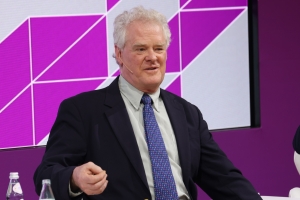
- About
- Education
- Research
- Engagement & Collaboration
- News & Events
Back to Top Nav
Back to Top Nav
Back to Top Nav
Back to Top Nav
At the recent CERAWeek 2025, the panel titled "Ethanol Evolves in the Energy Mix" convened experts from various sectors to discuss the pivotal role ethanol is playing in transforming global energy landscapes. Moderated by Christoph Berg, Global Team Leader of Biofuels Analytics at S&P Global, the panel included Doug Berven, Vice President of Corporate Affairs at POET; Lee Lynd, Professor of Engineering at Dartmouth College; and Shrikant Rathi, Regional Head of Americas at Praj Americas Inc. Together, they explored the present and future potential of ethanol as a vital component in the energy mix.
Ethanol's legacy spans 150 years of combustion usage, but its momentum is increasing as global markets discover its potential as a decarbonization tool. Doug Berven highlighted how 2024 emerged as a record year for ethanol, mainly driven by a surge in exports despite stagnation in the U.S. domestic market, where ethanol constitutes 10% of the fuel supply. The global view on ethanol is shifting as a viable strategy for economic and environmental sustainability, notably in Africa, which looks to the Midwest blueprint as it embarks on its own green revolution.
The discussion delved into emerging markets, particularly India, which has seen remarkable growth in ethanol production due to energy security challenges and a commitment to integrating agricultural economies with energy markets. Shrikant Rathi attributed this rapid progress to robust policy support and India's agrarian strengths, achieving and even surpassing production targets by 2024. India's policy shift towards ethanol blending is seen as a stepping stone to a cleaner energy future.

Lee Lynd highlighted the critical need to move beyond first-generation feedstocks, which have their limitations in terms of availability and environmental impact. He advocated for the adoption of second-generation feedstocks, such as agricultural residues, which can be cultivated without requiring additional land, thereby mitigating land-use concerns, as well as purpose grown crops. With the advancement of precision agriculture, the integration of perennials and crop residues into biofuel production will become increasingly important. Furthermore, Lynd pointed out the often underestimated potential for carbon capture within biofuel processes. He illustrated that cellulosic biofuel production, when combined with carbon capture techniques, can achieve a carbon intensity as low as minus 150. This essentially results in the removal of carbon dioxide from the atmosphere, highlighting a compelling pathway towards negative-emission biofuels.
The panel also covered the burgeoning markets for ethanol, including maritime and sustainable aviation fuel (SAF). Doug Berven noted the economic and technological adjustments necessary to tap these robust markets, where even California's conservative approach towards E10 (10% ethanol blend) contrasts with other regions moving towards E20 and beyond. Brazil's E27 blend exemplifies the global variations in ethanol blending practices.
Shrikant Rathi shared insights on India's SAF policy mandating 1% ethanol blending by 2027, highlighting the need for clear carbon accounting. The potential for ethanol's carbon intensity reduction was quantified by Lee Lynd, stressing three primary strategies: minimizing inputs, maximizing outputs, and capturing CO2. Organic biofuels present significant CO2 capture opportunities, with initiatives like POET's CO2 capture across multiple plants demonstrating practical applications.
In conclusion, the "Ethanol Evolves in the Energy Mix" panel underscored ethanol's transformative capabilities, not only as a fuel but as a catalyst for sustainable innovation in the energy sector. As the global demand for cleaner, more efficient energy systems grows, ethanol emerges as a key player, with policy, technology, and diverse feedstock strategies converging to drive this renewable energy forward.
CERAWeek is regarded as one of the most influential annual conferences in the energy sector, drawing nearly 10,000 executives, policymakers, investors, entrepreneurs, and scientists from around the globe. Attendees engaged in a week filled with hundreds of discussions, covering topics such as domestic energy production, the influence of AI on energy systems, the rapid deployment of solar energy, the evolving policy landscape, and pioneering carbon capture technologies.
The Irving Institute brought 25 delegates who actively networked with industry leaders and exchanged ideas. Our faculty, staff, and affiliated startups delivered over two dozen presentations throughout the week.